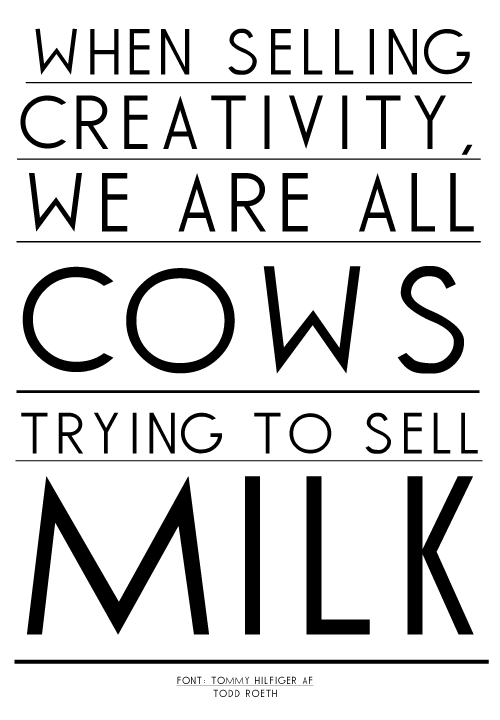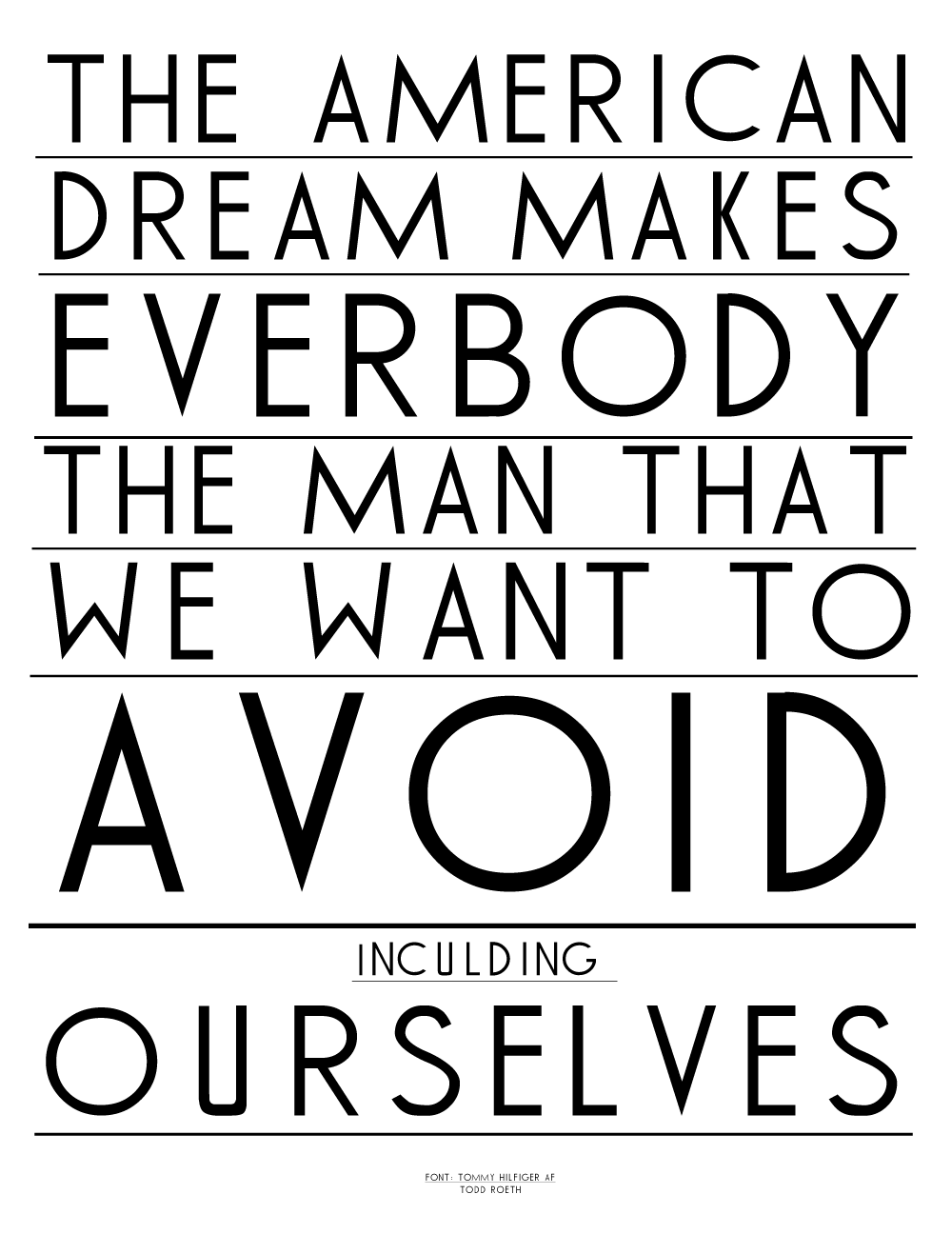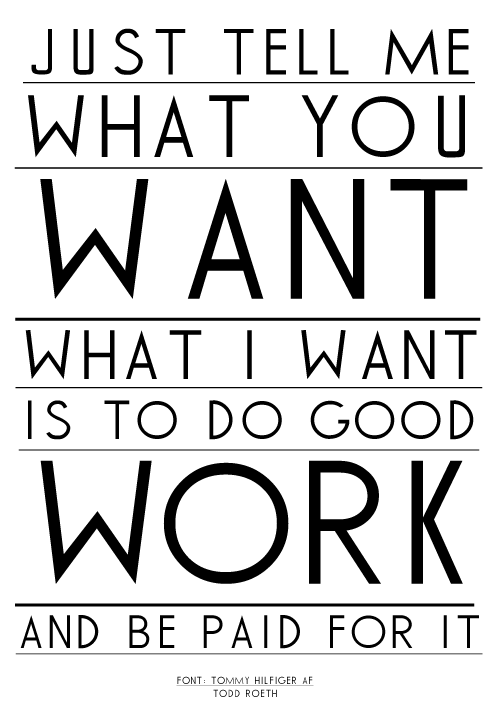The prevailing notions that have been the foundation the last ten years of my professional life are: #1 working for yourself is great, #2 that technology allows for telecommuting so that you can live in one locale and work in another, and that it will be easy, and #3 doing what you love will give you a happy life.
After ten visceral years of living this experience to my fullest capabilities, I have removed all the vague but powerful impulses that have led me down this road, and I am able to isolate and identify these grand assumptions. With many experiences behind me, I am now able to learn from my own history, and correct it so that I might better myself as I continue through life.
Correction #1: working for yourself is great.
Firstly, a popular manifestation of the American Dream says that working for yourself and doing what you love is great. Working for yourself can be great. But not really, and not all the time. Not even half the time in my experience. But like any idea, we have been led to believe in the exceptional, and that is not ever the norm. Working for and by yourself can be great, but that is not usually the case in my experience. (It’s called work for a reason.) And my experiences all lie within what outside agencies and institutions like the IRS and insurance applications categorize as the ‘Creative Economy’: artistic services like graphic design, web design, copywriting, illustration, informational-graphics, photography. These are all disciplines I have experience in; I have sold and performed them all during my time as a professional designer.
When working for yourself, the impulse is to feel and celebrate that you are eschewing ‘The Man’. The archetypal “Man” is anybody who is in the authoritative position to tell you what to do, whether they know better or not. By working for yourself, the implication is that there is no one who can tell you what to do, that you are your own boss. The reality is, that when working for yourself in the ‘Creative Economy” you trade in the singular ‘Man’ for many, many “Men”. Everybody you work for is the Man. This is because when providing a service, your clients and customers dictate the success and completion of your work. And we have all been led to believe that was as customers are always right, especially my customers.
To Work for yourself, you work for everybody else, and by their decisions
I work for myself in a very subjective occupation. The individual and intuitive nature of the work I do bears nearly all of the joy and struggle of my work and much of my lifestyle. More objective pursuits of income are very different. If I am an auto mechanic, I fix my client’s cars for my livelihood. Sure, there are many possible approaches and strategies to the reach the solution, but there is an agreed upon understanding I have in this transaction with my client. When the serpentine belt breaks and their car won’t move, we can both agree that when I replace the belt and adjust the pulleys, and the car moves and operates as it did before, the service has been complete and done to the customer’s satisfaction. But what about when a client comes to you because they want a new website, or new photography, or any new way to communicate themselves, their business, or products?
The difference can be summed up as this: cars have been around for a long time and we know what to expect from them. When they don’t work, we can easily recognize their shortcomings, and can clearly define the criteria for successful service – and more importantly, we can envision the solution. (I want my air conditioning to work again. I will be able to recognize when it is.) Modern mediums of story telling have not been around very long and people’s understanding, definition, and purpose of the internet, social networking modes and memes, video and television broadcast, and the countless formats for transmitting messages widely, wildly, varies.
To narrow down this comparison a little, I’ll cite a website for my example. When websites don’t work, people have a much harder time recognizing why. Technical issues are much easier to identify, and technical solutions are easier to envision. (I want my website to look the same way on all browsers. I will be able to recognize when it is.) But when websites don’t work, the problem clients almost always are trying to explain is this: my website does not tell the right story. The difference between this and car repair is vast. So are the solutions.
This comparison is the best way for me to compare and understand the larger picture I have lived in. My career is founded in the business of solving problems and improving people’s ability to tell their stories. Sometimes this involves words, often pictures, sometimes charts, usually typography, organization, and readability. These solutions don’t exist when I embark on my work. I need to create the solution, and – now here is the real trick – I need provide a solution that fits within the limits of understanding, expectations, tastes, intellectual boundaries, and within the budget of my clients. When working myself, my success is bound to the decisions and responsiveness of my clients . And I work in a time when the entitlement and expectation of anyone receiving service leaves little room for compromise nor little protection for the business that provides the service.
People in need of design services don’t have the vocabulary or the exposure to other examples or similar ideas to communicate what they want. Or sometimes, they just don’t know, but they are still the final decider in their success and approval. It’s hard to get paid until a project is done, as you may imagine. In a service based business model, volume and faster through-put is the only way to grow revenue. If clients could define the problem themselves, they would do a lot better at understanding the solution. But if they knew they solution, what would they need me for? (Correction #3 later attempts to answer this rhetoric.)
Creative design should be defined by what it solves, not by how it looks
My work should do two things: solve problems (communicate ideas better) and look good. Often, clients only think in terms of the latter. They will not be correct unless my clients are able to agree with them. This fact is true no matter what type of employment I have in the creative economy – perhaps any service. (Including the profession of a teacher. I have been a teacher and learned this rings true in the business of education too. More on this in correction #3.)
When self-employed in the service sector, one’s income comes directly from the completing of the solicited service. But the important point I need to identify for myself is this: the completion of my service cannot be defined when the service starts. That is a the major reason it is called ‘creative’ service. I get paid to create a solution, and I am most successful when the solution is most unexpected.
How do I reconcile creative integrity with the principles of a successful business? How do I provide what is original – inherently unexpected – to a clientele who does have expectations, ones that are often unable to be communicated to me. The customer is always right, if for no other reason because they are who directly provides my income. The customer is “The Man.” Every customer is ‘The Man.” And the man is who pays the money.
Imagine if I walked into my mechanic’s garage and said, “Fix my car. It’s not serving my purposes. Only I know my needs and only I can envision what it will be like when it is fixed, and I don’t have the vocabulary to share this with you. How much will it cost and when will it be done?” The mechanic would have a very different business model indeed. This is the model I need to still better understand.
This is not art. I am not here to change anyone’s minds. This is a service.
Competition and lean profits today dictate we all remove any costs of doing business in order to offer the lowest price possible to the client. Paying for someone to teach you new ideas is not part of anybody’s budget today. That’s what college is for, right?
Increasingly, I have taken the position that I will remove my own opinions and creative ideas, and continually focus on executing my clients ideas just as they want them. “Customer-Centric-Service” is what copy writers call this strategy in today’s terms. But that approach exposes the bare fact once again: clients often don’t know what they want, they only have vague but cemented positions on what they expect, and cannot express them. How do you create competitive pricing for this line of work? Most often, client’s can only tell you what they want after they see it. As such, I have often finished a project and while auditing the time spent on a project realize that sometimes as little as 25% has been spent performing the work, and 75% explaining, encouraging, adapting, redefining, asking new questions, re-proposing, and sometimes, placating the clients’ emotional stakes in the project. (While far from a masterpiece, this website was created, designed, and launched in 6 hours, that is to say, I knew what I needed very clearly, and realized that how that looked in the end would be a result of the solution. See this visual aid inspired by Richard Buckminster Fuller.)
Some might think, isn’t your job to educate and inform the client of the best solution? Aren’t you supposed to change people’s positions on their viewpoints and expectations of what good design and effective communication is? Isn’t that what you are being paid for?
I have asked myself these questions for over ten years, and my conclusion is this: No. I am not paid to teach and persuade and change clients’ minds. They don’t want to be changed. They want to be verified; verified that their tastes, their ideas, and their visions and opinions have been correct; that my solution looked like what they thought it would all along, but where unable to express to me. That is my job – to find a way for the customer be right.
Clients don’t have the time, interest, or capacity to learn or consider something new; they have plenty else to deal with. They certainly don’t want to pay for the time it takes to do so. If I wanted to take on this cause, it would have to be of my own time and effort, and not be billed to the client, and their is no guarantee it would be appreciated. My experience says it will not. It is more valuable to me and in my self-interest to learn more about my client’s behavior than it is to teach them how and why I do what I do.
Everybody can already to what I do. They just pay me because it is easier. Until it’s not.
This is is one of my life’s big “corrections’ to date. This is what I have realized for myself: Working for yourself can be great, but will never be as good as the idea, and it will never last. A do-it-yourself career seems to be the natural conclusion in the American cultural landscape where “Do-It-Yourself” is nearly a name brand all itself. We all want to self-service our needs. That is why the ATM is what it is. (Sorry about that one, bank tellers.) We want to, and have convinced ourselves, that can we do more and more on our own. I know I have. We want to grow our own food and teach our own kids, and choose our own custom health insurance coverage. Why pay someone else? That’s expensive. In the creative industry, like anywhere else, it’s only natural that doing-your-own-carreer seems so desirable. Until you realize that the work you want to base your own career on is no different than anything else to the rest of the world: the service or goods I provide are just something else that others can do on their own. Sure, a professional might do it better, but quality is not a desire or virtue I see discussed any more: ‘fast’ and ‘cheap’ are the new ‘quality’ and ‘craft’. Why pay someone else? That’s expensive, remember? And the one thing, above all, that we believe we can do, is be creative ourselves. In case you are not convinced, consider this: how conceited would I sound if I suggested you couldn’t be creative on your own, and had to pay me do so?

The conclusion I have found while working for myself in the ‘Creative Economy’ is one of paradox. The more we expect that our own creative abilities will be paid for in the open market, the less our carriers will be viable. If we want to work for ourselves, and be creative ourselves, and tell our own stories ourselves, then we must also remember, so does everyone else. We all write in our own blogs, but spend much less time reading others. To survive, you must be really good. That has always been the case. But in my line of work, it means that lots and lots of people need to think you are good. Furthermore, they also have to have money and lack the notions and that their ideas are as creative as yours. And how conceited would I sound if I told you I am more creative than you?
In conclusion, I have found that working for myself in the creative world will not yield a satisfactory career for me because design is subjective. Enormous amounts of head scratching, provisions, and contract proposals and budget re-writing will not find an efficient or lucrative formula that takes customer’s qualitative impulses and convert them to quantitative business models. It is too expensive to do business when the client is always right, but the client can’t tell you what that means, and won’t pay for me to find out. Working for myself means everybody is ‘The Man” – everybody is my boss, and I must work according to their tastes and on their schedule – both of which are too expensive to try to understand, and change too often to ever make a stable plan or business budget, let alone personal schedule or financial predictions. In the end, the skills I have worked to be distinguished by, the same ones that I perform in order to be able to demand wages paid in actual U.S. Currency, are at the end of the day something that my clients always have the final approval in, and always have the option of doing on their own, or find someone who will gladly do it for free, just for the experience and exposure. This is my correction, this what following my dreams have taught me. It is not all bad. In fact is has served me fairly well, and I would trade nothing for the experiences and clarity the work has brought me. Besides, I could be wrong in all of this, but I can tell you who is right. And you can be right too, if you have a budget to spend with me.
Footnotes: Top 5 reasons why “The Customer Is Always Right” Is Wrong


One thought on “The Correction, Part 1”
Comments are closed.